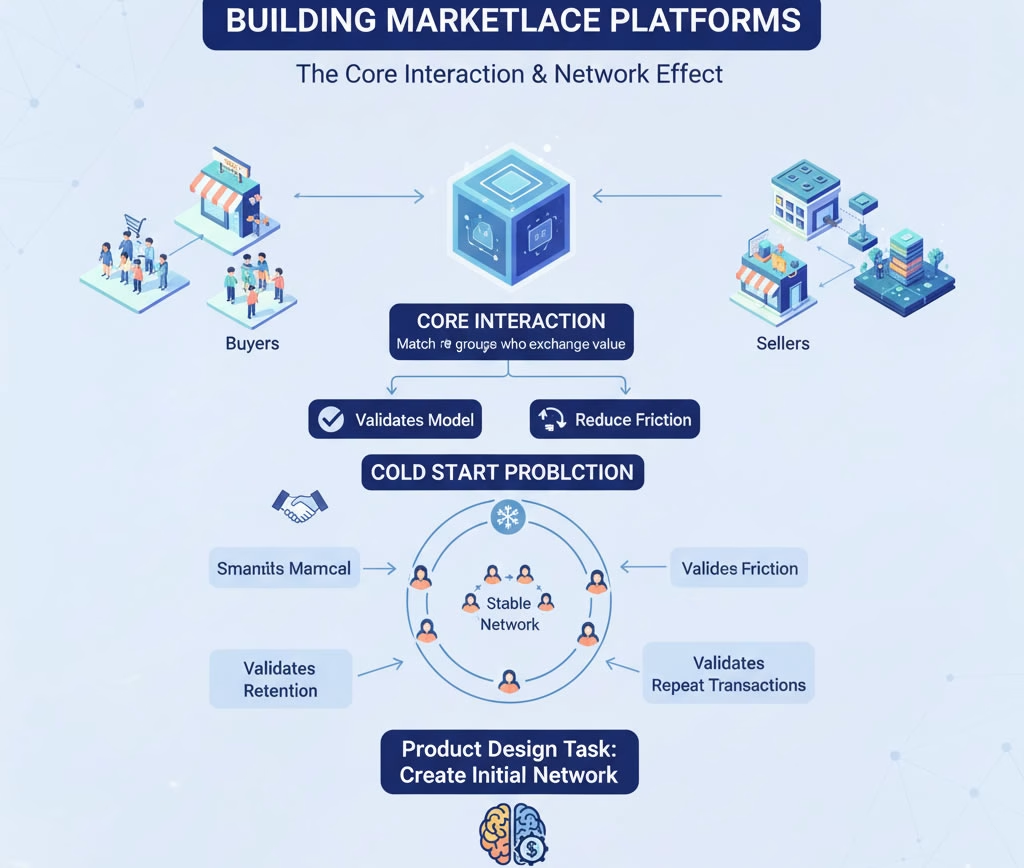
A marketplace exists to match two or more groups who exchange value. Design decisions must begin with a clear definition of the core interaction that creates value for each group. Start by defining the smallest viable transaction that proves the model; design interfaces that reduce friction for that interaction. The network problem at launch is the cold start problem; treat the initial phase as a product design task focused on creating a small stable network that validates retention and repeat transactions.
Business models to consider:
- Single product marketplace where the platform lists inventory.
- Commission marketplace where sellers list products and pay a fee per transaction.
- Subscription marketplace where sellers pay recurring fees for access to buyers.
- Service marketplace that facilitates bookings, appointments or gigs.
- Hybrid models that combine listing fees, commissions and subscription plans.
Key metrics that govern early product decisions:
- Liquidity metrics: time to first match, fill rate for listings and buyer conversion rate.
- Retention metrics: repeat buyer rate, repeat seller activity and churn on both sides.
- Unit economics: lifetime value per buyer and per seller against acquisition cost.
- Trust metrics: dispute rate, refund rate and NPS for both buyers and sellers.
Trust and reputation are design problems with product solutions. Present clear seller verification badges and concise review summaries. Build a friction minimal dispute flow with clear resolution steps. Make reputation visible at the point of decision without creating information overload. Use progressive disclosure for full seller history; place the most relevant trust signals near the buy path. Link to internal content about brand architecture to align marketplace presentation with overall brand identity. Brand architecture.
Onboarding must be optimized separately for sellers and buyers. Seller onboarding must solve supply problems first. Offer CSV bulk import for product catalogs; provide curated onboarding tasks that yield the first sale quickly. For buyers, focus onboarding on the fastest path to the first conversion; use curated starter lists for new users.
Product decisions at launch should be ruthless; narrow the scope to one vertical, one geography or one user cohort to reduce complexity while gaining product market fit. After validation, expand features iteratively while preserving the core interaction quality.
UX, product pages, vendor tools and payments
User experience priorities for a marketplace:
- Fast discoverability through an architecture that supports search, filters and facets tuned to the vertical.
- High quality product detail pages that show essential information first; lead with price, availability and primary images followed by specifications and shipping expectations.
- Mobile first design where touch targets are large; place checkout trust signals on every step of the mobile flow.
- Clear microcopy for fee structure so sellers understand commissions and buyers see total cost early.
- Progressive onboarding that shows sellers and buyers their next actions in plain language.
Listing strategy and media:
- Require a primary image at launch. Use aspect ratios that match the category expectations; show at least one zoomable image in the product detail template.
- Support multiple variants without complicating the initial listing form; allow simple SKU entry for early adopters.
- Store images in WebP with fallbacks to improve performance. Use lazy loading for offscreen images and explicit width and height attributes to reduce layout shifts.
Vendor dashboard essentials:
- Sales overview with pending payouts and recent orders.
- Simple product management with bulk import and bulk edit tools.
- Clear payout history plus dispute and refund workflow controls.
- Onboarding checklist that guides new vendors to their first sale.
Payment orchestration choices set the platform’s operational complexity and regulatory profile. For most marketplaces use a payments provider that supports split payouts, connected accounts and escrow like Stripe Connect. Stripe Connect provides the primitives to onboard connected accounts, route payouts and comply with local payment requirements.
Alternative payment providers are valid choices based on region and regulatory needs. PayPal offers platform payments and pay later options that increase conversion in some markets. MANGOPAY is optimized for marketplaces that require escrow accounts in the European market. Choose a provider based on supported payment methods, coverage for seller verification, available payout rails and fee structure.
Platform implementation options:
- WordPress with WooCommerce and a marketplace plugin provides a fast path to launch with lower engineering cost. Popular plugins include Dokan and WC Vendors for vendor management and payouts. Dokan docs WC Vendors.
- Hosted marketplace platforms provide a turnkey stack and scale operations for you. Sharetribe is an example of a hosted marketplace solution that accelerates time to market while handling payments and operations. Sharetribe.
- Enterprise marketplace platforms such as Mirakl fit retailers and B2B businesses that need custom integration with ERP and catalog systems.
- Custom builds using a headless CMS plus a modern frontend framework give maximum control over UX and performance; implement only if you need bespoke flows that off the shelf tools cannot support.
Use webhooks and workflow automation to decouple event handling from marketplace logic. Services like n8n provide an open workflow canvas for onboarding automation, KYC signals, payout triggers and asynchronous tasks. Implement webhooks for order creation, payment state changes and dispute events so auxiliary systems can react without blocking the checkout. n8n webhook docs.
Tech architecture, performance, SEO, accessibility and compliance
Architecture patterns to choose from:
- Monolithic approach using WordPress and WooCommerce with marketplace plugins for rapid launch and low initial cost.
- Headless CMS approach that uses WordPress for content and a frontend framework such as Next.js for the public site; this enables pre rendering, better performance and modern frontend routing.
- Microservices for large marketplaces that need separate services for catalog, orders and payout orchestration; use event driven patterns for scalability.
When using headless WordPress implement WPGraphQL or the REST API as the canonical data source; ensure correct canonical URLs for SEO when pages are pre rendered. Use incremental static regeneration or server side rendering for updates to listings while preserving crawlable HTML. WPGraphQL.
Performance and search optimization are mandatory. Core Web Vitals define the critical metrics for loading performance, interactivity and visual stability. Optimize largest contentful paint by prioritizing critical resources and using a CDN for assets. Eliminate layout shifts by specifying image dimensions and avoiding layout triggering animations. Track these metrics continuously using field data and automated audits.
SEO fundamentals to implement:
- Unique descriptive title tags and meta descriptions for listing pages.
- Structured data for products and offers in JSON LD so search engines can render rich results for listings.
- Robots configuration plus an XML sitemap that includes canonical listing pages and vendor stores.
- Server side rendering or pre rendering for critical pages to ensure search engine bots receive full HTML content.
Accessibility matters for both legal risk and conversion. Follow W3C WCAG guidelines to reach at least AA conformance. Implement semantic HTML; provide alt text for images and ensure keyboard navigability for listing carts and checkout forms. Test with automated tools and manual assistive technology checks.
Data protection and compliance:
- For platforms operating in or serving EU users apply GDPR principles for lawful basis, data minimization and user rights. Document processing purposes and assign a data protection lead where required.
- Log and audit KYC and seller verification procedures while protecting personal data using encryption at rest and in transit.
- Design data retention policies and provide interfaces for data access requests and deletion where required by law.
Security and trust operations:
- Use CSP and HSTS for transport and content security.
- Apply least privilege to databases and service accounts; rotate keys and secrets routinely.
- Implement monitoring for fraud and unusual payout patterns; integrate 3rd party fraud services where needed.
Operational tooling:
- Implement observability for user flows using analytics for funnels plus error tracking for both client and server side code.
- Automate deployments with CI pipelines; run automated Lighthouse checks to prevent performance regressions.
- Plan customer support flows that connect buyers, sellers and ops teams; provide transparent dispute meta data to reduce manual handling time.
Final notes on vendor economics and growth:
- Balance fees to keep suppliers profitable while funding platform operations; test pricing physics on small cohorts before global roll out.
- Focus growth on categories where you can maintain quality and control supply; protect that supply using marketplace specific incentives such as guaranteed payouts or featured placement.
- Measure and improve the core interaction iteratively; prioritize the metric that best indicates healthy exchange in your marketplace and optimize toward it exclusively for short cycles.
Selected external reference links
- Stripe Connect docs
- Sharetribe hosted marketplace
- Dokan marketplace plugin docs
- Core Web Vitals overview on web.dev
- EU data protection overview
- n8n webhook docs
- WC Vendors marketplace plugin
- Wemaxa services
Implementation checklist for the first 90 days:
- Ship a minimal listing flow for one vertical; validate first 100 transactions.
- Integrate a payments provider that supports connected accounts and ensure test payouts succeed.
- Deploy analytics, automated Lighthouse checks and Core Web Vitals monitoring.
- Implement seller onboarding with a first sale checklist and a simple dispute flow.
- Document privacy and data processing; publish a clear privacy notice and contact point.
Marketplace web design: Complete guide
Digital commerce has matured beyond the era of simple online stores and is now dominated by interconnected ecosystems where value is exchanged across multiple participants. A marketplace website gives you the ability to operate not just as a single vendor but as the host of an entire digital economy. The difference is fundamental: while a standard online shop depends entirely on the owner’s ability to maintain inventory, negotiate logistics and drive marketing campaigns, a marketplace transforms into a compounding growth model where every new vendor you attract multiplies the value for buyers and strengthens your brand authority. This network effect cannot be replicated by a traditional store and is precisely why global leaders such as Amazon, Etsy and Airbnb have become dominant forces. Without a marketplace you remain locked into linear scaling where growth is tied to your own resources. With a marketplace, every seller you onboard increases variety, every new product improves discoverability, and every successful transaction reinforces your platform as the natural hub of its niche. At Wemaxa we specialize in building marketplaces that embody these compounding mechanics from day one, ensuring that your platform grows as an ecosystem rather than as a solitary store, positioning your brand for long term dominance instead of temporary gains.

Trust and credibility are the true currency of marketplaces, and no amount of advertising can compensate for a design that fails to establish safety. Visitors are not simply buying a product or service; they are evaluating whether your platform itself can be relied upon. Without embedded trust signals, user adoption stalls and vendors quickly abandon your site. Wemaxa addresses this reality by treating trust as a design priority, not as an afterthought. Our marketplace frameworks include verified seller profiles, transparent reputation systems, visible dispute resolution processes and secure, compliant payment gateways that are woven directly into the user interface. Instead of overwhelming visitors with cluttered disclaimers or buried policies, we place concise trust indicators at the exact points of decision checkout, vendor profile, listing detail so that buyers feel immediately reassured and sellers recognize your commitment to fairness. This integration of credibility into the very architecture of the site reduces abandonment, increases conversion rates and builds the brand equity that cannot be faked through marketing campaigns alone. By letting your design communicate safety from the first click, Wemaxa helps you establish a marketplace where trust is not requested but assumed.

User experience is where marketplaces either thrive or collapse. A buyer who cannot find what they are looking for in under three clicks will abandon the platform without hesitation, and a seller who struggles to list a product efficiently will churn before ever making a sale. The marketplace environment is competitive, and convenience always dictates loyalty. At Wemaxa we design user flows with obsessive clarity: category navigation that reflects how real customers think, filtering systems that cut through noise, search algorithms tuned to context, and checkout sequences streamlined for mobile use where the majority of traffic originates. We test these flows rigorously to eliminate every unnecessary click, every ambiguous label and every performance bottleneck that creates friction. Our philosophy is that UX is not decoration but the essential infrastructure of growth, because the marketplace that is easiest to use will always outperform those that demand patience or technical literacy. Whether it is guiding first time buyers to a relevant product in seconds or providing vendors with a dashboard that simplifies complex inventory management, our designs deliver the invisible convenience that transforms casual visitors into repeat users.

Performance is often underestimated by businesses until it directly destroys revenue. Modern buyers will abandon a page that takes longer than a few seconds to load, and search engines now measure loading speed, interactivity and visual stability as explicit ranking factors. A sluggish marketplace is not only unpleasant to use but will be buried beneath faster competitors in organic results. At Wemaxa we treat performance optimization as a core design responsibility. Every marketplace we build incorporates next generation media formats like WebP with automated fallback, caching layers tuned for real world conditions, and infrastructure scaled to handle traffic spikes without collapsing. We optimize Core Web Vitals to guarantee fast rendering of product images, instant interaction with forms and checkout flows that remain stable across devices. The result is a platform that feels effortless to buyers and efficient to sellers, regardless of catalog size or concurrent users. These design decisions are invisible when executed correctly, but their impact on revenue, retention and discoverability is dramatic. By ensuring your marketplace is engineered for speed from its foundations, Wemaxa safeguards your growth against both user impatience and algorithmic penalties.

Another decisive advantage of a marketplace lies in its economic flexibility. A properly designed platform allows you to monetize through commissions, listing fees, subscriptions, advertising placements and premium visibility options. However, poor design around fees and payouts can create friction that undermines retention. Sellers must see exactly how much they earn, when payouts are scheduled and what fees are deducted. Buyers must see total costs transparently before checkout to avoid disappointment. At Wemaxa we create dashboards that give sellers immediate visibility into their sales pipeline, pending payouts, dispute statuses and growth analytics. Buyers are guided through checkout sequences that display accurate costs early in the process, reinforcing trust and preventing last second abandonment. We also design administrative tools for platform owners that make fee management, commission adjustments and promotional campaigns straightforward to implement without requiring technical intervention. By aligning design with economic clarity, Wemaxa ensures that your marketplace not only functions but thrives, with monetization models that vendors embrace rather than resist.

Scalability is the silent requirement of every successful marketplace. Many platforms launch with a few dozen listings and limited traffic, only to collapse under the strain of growth when thousands of products, vendors and transactions arrive. Architecture must therefore be designed for expansion from the outset. Wemaxa implements scalable databases, modular plugin integrations and cloud ready infrastructure that prevent bottlenecks before they appear. We plan for growth in catalog size, traffic surges, geographic expansion and regulatory changes by building adaptability into the structure itself. As your marketplace scales, features such as advanced search, personalized recommendations and AI driven fraud detection can be layered on without needing to rebuild the foundation. This long term perspective protects your investment by ensuring that the marketplace you launch today remains viable tomorrow, even under exponential growth. With Wemaxa you do not buy a temporary solution but a durable digital platform engineered to evolve with your business ambitions.

Brand differentiation is critical in a world where buyers are confronted with endless choices. A marketplace that looks and feels generic will not inspire loyalty. Design is more than aesthetics; it is a strategic tool to communicate your positioning, values and authority. At Wemaxa we align marketplace design with your brand architecture, ensuring that every element from typography to color palette to iconography reinforces your unique identity. We integrate storytelling into landing pages, highlight vendor success stories and use visual cues to make navigation feel intuitive yet distinctive. This creates a brand atmosphere where buyers perceive quality and sellers feel pride in associating with your platform. A marketplace designed by Wemaxa does not merely function; it resonates emotionally with your audience, transforming transactions into relationships and visitors into advocates. By elevating design from surface decoration to strategic communication, we give your marketplace a presence that cannot be copied by competitors.

Ultimately, the question is not whether your business can afford to build a marketplace but whether it can afford not to. In every industry marketplaces are emerging as the dominant digital model because they scale faster, generate diversified revenue streams and create defensible ecosystems that individual stores cannot replicate. The longer you delay, the more entrenched competitors become and the harder it is to capture mindshare. By partnering with Wemaxa you gain not only technical execution but strategic insight, design expertise and operational foresight. We deliver platforms that are visually compelling, structurally robust, compliant with international standards and optimized for both search engines and human behavior. Our work ensures that when prospects visit your marketplace
Quick internal references:
Wemaxa services,
E commerce,
AI integration,
Pricing plans,
FAQ,
Maintenance.


